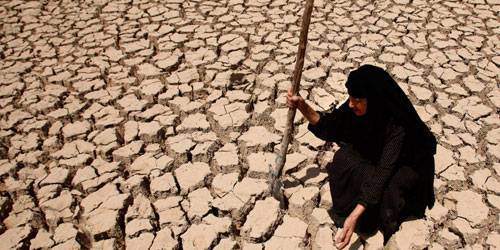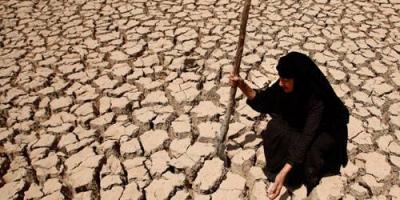Mustafa Ahmed gently pats the water buffalo before tying a feed bag around its neck, tending to the herd owned by his father in Najaf province, southern Iraq. This is an activity that has been passed down through generations, but now, water scarcity looms like a sword threatening to disrupt livelihoods and change their way of life entirely. Iraq is part of the "Fertile Crescent," an area extending from the Mediterranean coast to the Gulf, where its inhabitants have relied on agriculture for thousands of years. However, conditions have changed, and everything is at risk of destruction due to several factors, including dam construction on the Tigris and Euphrates rivers, decreased rainfall, and decades of conflict.
Ahmed Abdul Hussein, Mustafa's father, laments the severe water shortage in their neighborhood of Al-Mishkhab, which has compelled him to sell one herd member after another, a painful experience, especially for his son. He says, "We recently lost a two-month-old calf. I feel sorrow for its loss... because I really love them... now we only have nine left." Last year, the herd numbered 20. Reuters spoke to six families of herders and breeders in Najaf province, all of whom said they had no choice in recent months but to either sell their livestock or watch them die before their eyes. A local official noted that the number of water buffalo in the nearby Um Khashm area has plummeted from 15,000 five years ago to 9,000 today.
Khaled Shamal, spokesperson for the Iraqi Ministry of Water Resources, explained that Najaf province has only received about 40% of its usual water allocation this year. In the marshes of southern Iraq, the situation is worsening in an already fragile environmental area. The marshes are experiencing the worst heatwave in 40 years, and the Food and Agriculture Organization (FAO) reports that nearly 70% of the marshes have turned into barren land devoid of water. The spokesperson also stated that the water flow in the Tigris and Euphrates rivers has decreased by about 70% this year compared to previous decades. Officials and experts attribute the water crisis driving thousands to flee rural areas to dam constructions in Turkey and Iran, climate change, outdated irrigation techniques, and a lack of long-term management plans.
In Al-Mishkhab, the land as far as the eye can see has turned into barren expanses, and Abdul Hussein's animals are enduring dust storms from lands that were once cultivated, while the buffalo herd has very little water left to keep them cool. The quality of the water affects the health of the animals, as contaminated water weakens their immune systems.
### Agricultural Devastation
In addition to water shortages, a combination of factors exacerbates farmers' struggles to feed their livestock, including sharp declines in crop production and rising feed prices. The FAO states that the area of land used for agricultural activities across Iraq has dropped to about half of what it was in 2020. In Najaf province, the situation is deteriorating at an unprecedented rate, with the percentage of utilized land dwindling to just five percent of its 2020 equivalent, having nearly completely ceased rice cultivation due to water scarcity. Herdsmen like Abdul Hussein used to cultivate their own land or obtain cheap feed from rice farmers.
Abdul Hussein says, "When the buffalo don't eat... they don't produce milk," adding that his income has severely diminished since losing his primary source of profit, making it difficult to procure feed, which has mostly become imported and more expensive. As the sun began to set over Al-Mishkhab, he reflected, "In a few months, perhaps everything will end." He indicated that the only alternative is to move to the outskirts of Najaf, where other family members live, to access drinking water.
The International Organization for Migration reports that 62,000 people have been displaced across Iraq due to drought as of last year. Many have migrated from rural to urban areas, facing high unemployment rates and inadequate services. In a sparsely furnished living room, Abdul Hussein said he had taken his children out of school years ago to help care for the herd, expressing regret over this decision "more than anything else." UNICEF states that approximately seven percent of minors aged five to 17 fall under the category of child labor in Iraq.




